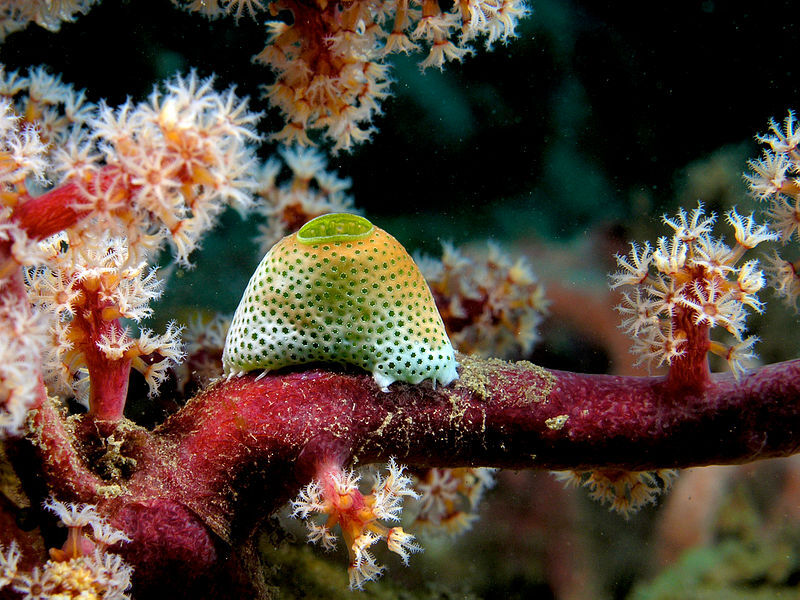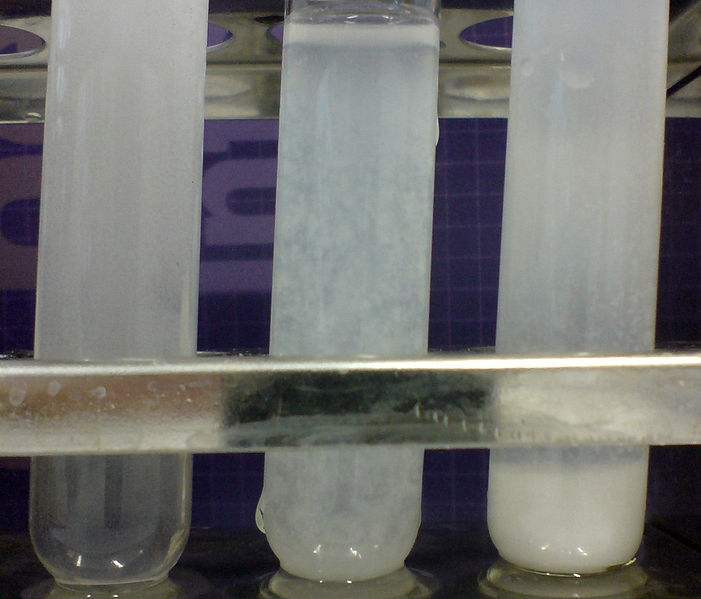The solubility product constant ( |K_{sp}| ) is the equilibrium constant associated with the ionization of an ionic compound that is poorly soluble in water.
Some solids are more soluble than others. This difference results from their respective solubility, a characteristic property that corresponds to the maximum quantity of solute that dissolves in a certain volume of solvent. When a solid exceeds the saturation point, the solution becomes saturated. A saturated solution that contains a deposit of undissolved solute at the bottom of the container is an example of a system at equilibrium. This is a solubility equilibrium since there is balance between the precipitate and the ions in solution.
The dissolution equilibrium of carbon dioxide in seawater is essential for the survival of marine organisms (left); the ionization constant of water is significant in this case. The formation of stalactites and stalagmites (right) is generated by the precipitation of calcium carbonate; the solubility product constant then plays a role.
Barium sulphate |(BaSO_{4})| is a salt that is poorly soluble in water (left). When placed in solution, often part of the solid does not dissolve (right). Thus, an equilibrium is established between the undissolved barium sulphate and the ions resulting from its electrolytic dissociation.
Based on the concentration of the ions obtained during the electrolytic dissociation, the solubility product constant can be established. |(K_{sp})|. It is worth noting that this constant can only be expressed for poorly soluble ionic compounds, since a solute deposit must be present. As no deposit is present in the case of a very soluble ionic compound, it is, therefore, not a system at equilibrium. The solubility equilibrium obtained following a partial dissolution of an ionic compound can be described by the algebraic expression below:
Consider a hypothetical reaction: |X_{n}Y_{m(s)}| ↔ |nX^+_{(aq)} + mY^-_{(aq)}|
The solubility product constant can be described by the following mathematical expression:
|K_{sp}=[X^+]^n\times[Y^-]^m|
where |K_{sp}| represents the solubility product constant
|[X^+]| and |[Y^-]| represent the concentrations of the ions at equilibrium (in mol/L)
|n| and |m| correspond to the coefficients of each ion
The solubility product constant is a variant of the concentration equilibrium constant |(K_{c})|. However, since the concentration of the solid does not vary, it does not appear in the solubility product constant calculation. Also, like all constants, the value of |K_{sp}| changes with temperature.
The solubility product constant allows compounds to be classified according to their solubility. The smaller the value of the constant, the less soluble the substance in water. However, this comparison can be made only for substances where the ions obtained have the same proportions.
Since solubility is affected by temperature, the solubility product constant will also be affected. To compare different substances, the data must, therefore, be determined under identical temperature conditions.
Here are the dissociation equations and the expression of |K_{sp}| for various substances:
- |CuCl_{2} \rightleftharpoons Cu^{+2}_{(aq)} + 2 Cl^-_{(aq)}| and |K_{sp}=[Cu^{+2}]\times[Cl^{-}]^2|
- |Ca(NO_{3})_{2} \rightleftharpoons Ca^{+2}_{(aq)} + 2 NO_{3(aq)}^-| and |K_{sp}=[Ca^{+2}]\times[NO_{3}^{-}]^2|
- |Ag_{2}SO_{4} \rightleftharpoons 2\ Ag_{(aq)}^{+1} + SO_{4(aq)}^{-2}| and |K_{sp}=[Ag^{+1}]^{2}\times[SO_{4}^{-2}]|
- |AgBr \rightleftharpoons Ag^{+1}_{(aq)} + Br^{-1}_{(aq)}| and |K_{sp}=[Ag^{+1}]\times[Br^{-1}]|
If the solubility of silver carbonate |(Ag_{2}CO_{3})| in water is |3.6\times10^{-3} g/100 ml| at 25 °C, what is its solubility product constant?
1. Dissociation equation and expression for |K_{sp}|
|Ag_{2}CO_{3(s)} \rightleftharpoons 2 Ag^+_{(aq)} + CO_{3(aq)}^{2-}| and |K_{sp}=[Ag^+]^2\times[CO_{3}^{2-}]|
2. Solubility calculation in mol/L
|n=\displaystyle \frac{m}{M}|
|n=\displaystyle \frac{3.6\times10^{-3}g}{275.8g/mol}|
|n=1.3\times10^{-5}mol \space for \space 100 mL|
|\text {Solubility}=\displaystyle \frac{1.3\times10^{-5}mol}{0.1 L}=1.3\times10^{-4}mol/L|
3. Calculation of the concentration of each ion at equilibrium
|[Ag^+]=2\times[Ag_{2}CO_{3}]|
|[Ag^+]=2\times1.3\times10^{-4}mol/L|
|[Ag^+]=2.6\times10^{-4}mol/L|
|[CO_{3}^{2-}]=[Ag_{2}CO_{3}]|
|[CO_{3}^{2-}]=1.3\times10^{-4}mol/L|
4. Calculating |K_{sp}|
|K_{sp}=[Ag^+]^2\times[CO_{3}^{2-}]|
|K_{sp}=(2.6\times10^{-4}mol/L)^2\times(1.3\times10^{-4}mol/L)|
|K_{sp}=8.8\times10^{-12}|
The value of the solubility product constant of silver carbonate is |8.8\times10^{-12}|.
What is the |Ag^{+}| ion concentration for a saturated solution of silver sulphate |(Ag_{2}SO_{4})| if its solubility product constant is |1.4\times10^{-5}| ?
1. Dissociation equation and expression for |K_{sp}|
|Ag_{2}SO_{4} \rightleftharpoons 2\ Ag_{(aq)}^{+1} + SO_{4(aq)}^{-2}| and |K_{sp}=[Ag^{+1}]^{2}\times[SO_{4}^{-2}]|
2. Calculation of the concentration for each ion at equilibrium
Based on the dissociation equation, we find that at equilibrium, the ion concentration for |Ag^+| is twice as large as that of |SO_{4}^{-2}|. Thereby:
|K_{sp}=[Ag^{+1}]^{2}\times[SO_{4}^{-2}]|
|1.4\times10^{-5}| = |(2s)^{2}\times(s)|
|1.4\times10^{-5}| = |4s^3|
By isolating the s, we find that its value is 0.0152 mol/L.
|[Ag^+] = 0.0304 mol/L|
|[SO_{4}^{-2}] = 0.0152 mol/L|
The following tools may be useful in calculations of |K_{sp}| :



